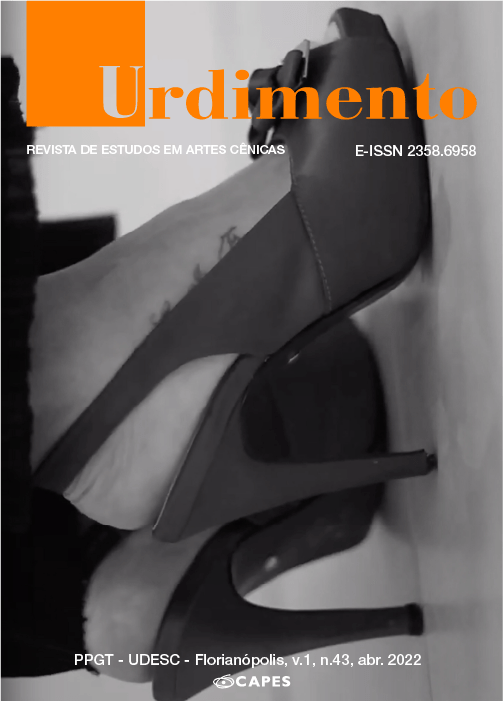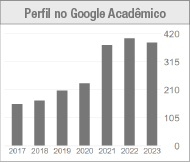How to break dams: Other political and artistic processes to repair the irreparable
DOI:
https://doi.org/10.5965/1414573101432022e0119Keywords:
Amazon, Altamira, Politics of the forest, ArtAbstract
Through a writing-in-route, the article presents some of the author's experiences during “Amazônia centro do mundo”, an event that, over three days, brought together indigenous leaders, researchers and activists in Altamira (PA), city where the world’s second largest hydroelectric power plant was build. The text is stitched together with Altamira 2042, a piece by Gabriela Carneiro da Cunha, aiming to argue that when the institutions prove incapable of repairing the irreparable, art can assume the responsibility of instituting other imaginations in those who share the artistic work.
Downloads
References
ANZALDÚA, Gloria. Falando em línguas: uma carta para as mulheres escritoras do terceiro mundo. Revista Estudos Feministas, Florianópolis, v. 8, n. 1, p.229–236, 2000. Disponível em: https://periodicos.ufsc.br/index.php/ref/article/view/9880. Acesso em: 21 jun. 2020.
BARAD, Karen. Posthumanist Performativity: Toward an Understanding of How Matter Comes to Matter. Signs: Journal of Women in Culture and Society, Chicago, v. 28, n. 3, p. 801–831, 2003. Disponível em: https://www.journals.uchicago.edu/doi/abs/10.1086/345321.
Acesso em: 29 jun. 2020.
BRASIL. Presidenta (-2016: Dilma Rousseff). Discurso durante cerimônia de início da operação comercial da Usina Hidrelétrica de Belo Monte. Vitória do Xingu, 05 mai. 2016. Disponível em: https://cutt.ly/kcEyDk2. Acesso em: 15 mar. 2020.
BRASIL, Instituto de Pesquisa Econômica Aplicada. Atlas da Violência - IPEA.
Disponível em: http://www.ipea.gov.br/atlasviolencia/download/19/atlas-da-violencia-2019. Acesso em: 5 mar. 2020.
BRUM, Eliane. Vítimas de uma guerra amazônica. EL PAÍS, online, 22 de set. de 2015. Disponível em: https://brasil.elpais.com/brasil/2015/09/22/politica/1442930391_549192.html .
Acesso em: 10 jun. 2020.
BRUM, Eliane. Belo Monte: a anatomia de um etnocídio. EL PAÍS, online, 01 de dez. de 2014. Disponível em:
https://brasil.elpais.com/brasil/2014/12/01/opinion/1417437633_930086.html.
Acesso em: 18 jun. 2020.
CARNEIRO DA CUNHA, Gabriela. Altamira 2042, 2019. [Espetáculo teatral].
CARNEIRO DA CUNHA, Gabriela. Entrevista concedida a Paloma Bianchi. Florianópolis-São Paulo (online), 11 de mar. De 2020. [Gravação em áudio – acervo da entrevistadora]
CLIFFORD, James. A Experiência Etnografica: Antropologia e Literatura no Século XX. Rio de Janeiro: UFRJ, 2011.
COLLINS, Patricia Hill. Aprendendo com a outsider within: a significação sociológica do pensamento feminista negro. Sociedade e Estado, Brasília, v. 31, n. 1, p.99–127, 2016. Disponível em: http://www.scielo.br/scielo.php?script=sci_abstract&pid=S0102-69922016000100099&lng=en&nrm=iso&tlng=pt. Acesso em: 21 jun. 2020.
FOSTER, Hal. The Artist as Ethnographer? In: MARCUS, George E.; MYERS, Fred R. (org.). The Traffic in Culture: Refiguring Art and Anthropology. Berkeley: University of California Press, 1995. p.302–309.
GEERTZ, Clifford. A Interpretação das Culturas. Rio de Janeiro: LTC, 2015.
GONZALES, Lélia. Racismo e sexismo na cultura brasileira. Revista Ciências Sociais Hoje, [online], p. 223–244, 1984. Disponível em:
Acesso em: 21 jun. 2020.
GREEN, Renée. Other Planes of There: Selected Writings. Durham: Duke University Press, 2014.
HARAWAY, Donna. Staying with the Trouble: Making Kin in the Chthulucene. Durham: Duke University Press, 2016.
KOPENAWA, Davi; ALBERT, Bruce. A queda do céu: Palavras de um xamã yanomami. São Paulo: Companhia das Letras, 2015.
LANGDON, Esther Jean. A performance da diversidade: o xamanismo como modo performático. GIS - Gesto, Imagem e Som - Revista de Antropologia, São Paulo, v. 1, n. 1, 2016. Disponível em: http://www.revistas.usp.br/gis/article/view/116460. Acesso em: 27 jun. 2020.
LEAL, Dodi Tavares Borges. Luz à sombra do som MITsp 2019, 2019. Disponível em: https://mitsp.org/2019/luz-sombra-do-som/. Acesso em: 24 jan. 2021.
LISBOA, Sílvia; MILANEZ, Felipe. Áudios comprovam que pastor assumiu área sensível da Funai para converter índios isolados. The Intercept Brasil, online, 13 de Fev. de 2020. Disponível em: https://theintercept.com/2020/02/13/audios-missionarios-converter-indios-amazonia/. Acesso em: 16 fev. 2020.
MALINOWSKI, Bronislaw. Os Argonautas do Pacífico Ocidental. São Paulo: Ubu Editora, 2018.
MARCUS, George E. O intercâmbio entre arte e antropologia: como a pesquisa de campo em artes cênicas pode informar a reinvenção da pesquisa de campo em antropologia. Revista de Antropologia, São Paulo, v. 47, n. 1, p.133–158, 2004. Disponível em: http://www.revistas.usp.br/ra/article/view/27184. Acesso em: 15 jun. 2020.
METUKTIRE, Raoni. Fala de Raoni durante o evento Amazônia centro do mundo. 2019. Gravação de áudio.
MOÇAMBA, Jota. lugar de fala. In: Ciclo de Conferências Vozes do Sul, Lisboa, 2017. Disponível em: https://www.facebook.com/jeferson.isaac/videos/1565383996857643.
MOVIMENTO XINGU VIVO PARA SEMPRE. Fazem com você o que você fez conosco; mas nem assim, Dilma… Organização Não-Governamental. 2016. Disponível em: https://xinguvivo.org.br/2016/05/05/fazem-com-voce-o-que-voce-fez-conosco-mas-nem-assim-dilma/. Acesso em: 17 mar. 2020.
RAMPLEY, Mathew. Anthropology at the origins of art history. In: COLES, Alex (org.). Site-specificity: The Ethnographic Turn. London: Black Dog Press, 2000. p. 138–165.
RIBEIRO, Djamila. Lugar de Fala. Belo Horizonte: Letramento, 2017.
RIBEIRO, Maria Fernanda. Após 15 anos da morte de Dorothy Stang, a impunidade ainda persiste em Anapu. Amazônia Real, online, 12 de fev., de 2020. Disponível em: https://amazoniareal.com.br/apos-15-anos-da-morte-de-dorothy-stang-a-impunidade-ainda-persiste-em-anapu/. Acesso em: 26 de fev. de 2020.
SIEGENTHALER, Fiona. Towards an ethnographic turn in contemporary art scholarship. Critical Arts, [online], v. 27, p. 737–752, 2013. Disponível em: https://www.tandfonline.com/doi/pdf/10.1080/02560046.2013.867594?redirect=1.
Acesso em: 16 jun. 2020.
SPIVAK, Gayatri. Pode um subalterno falar? Belo Horizonte: Editora UFMG, 2010.
STRATHERN, Marilyn. O efeito etnográfico e outros ensaios. São Paulo: Ubu Editora, 2017.
SZTUTMAN, Renato. O profeta e o principal: a ação política ameríndia e seus personagens. 2005. Tese (Doutorado em Antropologia Social) - Universidade de São Paulo, São Paulo, 2005. Disponível em: http://www.teses.usp.br/teses/disponiveis/8/8134/tde-01102007-144056/.
Acesso em: 27 jun. 2020.
VIVEIROS DE CASTRO, Eduardo. O nativo relativo. Mana, Rio de Janeiro, v. 8, n. 1, p. 113-148, 2002. Disponível em: http://www.scielo.br/scielo.php?script=sci_abstract&pid=S0104-93132002000100005&lng=en&nrm=iso&tlng=pt. Acesso em: 15 jun. 2020.
VIVEIROS DE CASTRO, Eduardo. Metafísicas Canibais: elementos para uma antropologia pós-estrutural. São Paulo: Cosac Naify, 2015.
Published
How to Cite
Issue
Section
License
Copyright (c) 2022 Urdimento - Revista de Estudos em Artes Cênicas

This work is licensed under a Creative Commons Attribution 4.0 International License.
Copyright Statement
The articles published by the magazine are free to use. The copyright is all assigned to the magazine. The articles whose authors are identified represent the expression from the point of view of their authors and not the official position of the journal Urdimento. The author (s) undertakes whenever publishing material relating to the article published in Revista Urdimento mention the said publication as follows: This article was originally published by Urdimento magazine in its volume (put the volume), number (put the number) in the year of (put the year) and can be accessed at:
http://www.revistas.udesc.br/index.php/urdimento
This work is licensed under a Creative Commons Attribution 4.0 International License.




